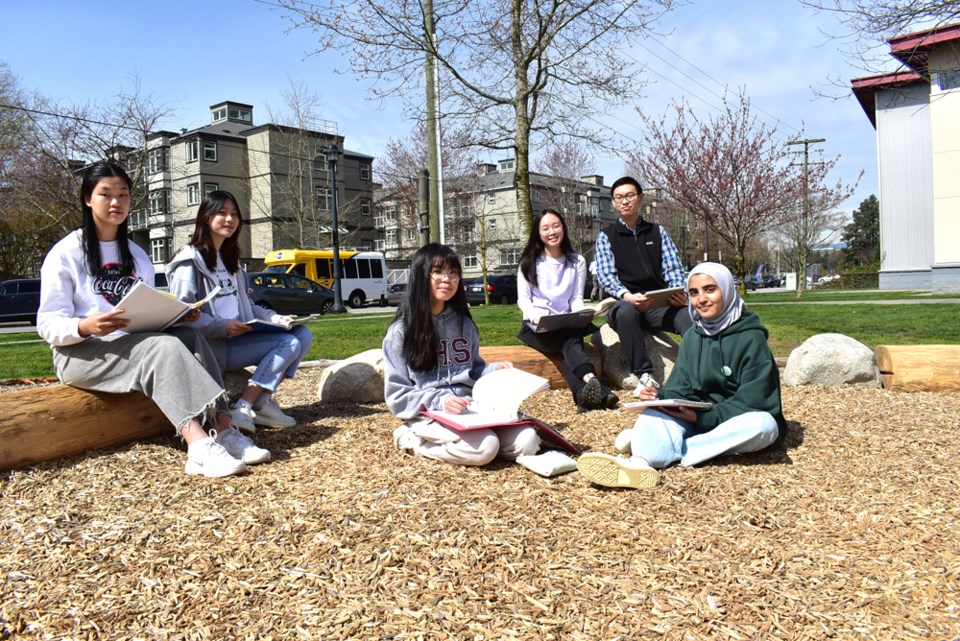A dense crescent-shaped “pocket forest” will soon start growing at Richmond Secondary, enveloping the school’s outdoor learning space.
This Friday, the school will celebrate Earth Day by starting to plant trees in the first-in-B.C. Miyawaki pocket forest, which is meant to create a cool space when it’s hot out, provide protection in inclement weather and add to biodiversity.
Richmond Secondary Green Team member Harry Peng said he hopes the pocket forest will be an “escape from suburbia” and be used by the entire community.
The climate change crisis — as seen by last year’s heat dome and atmospheric river — is “worrying” for Peng, especially as it will affect his generation.
“We’re going to be the ones living on this planet,” Peng said.
Peng used to live in Beijing where the air quality was sometimes so toxic, school would be cancelled, but he knows there’s work to be done in Richmond as well to protect the environment.
The widespread flooding last November could have been worse for Richmond and might be in the future with sea levels rising, Peng said.
The school and its partner in the pocket forest project, Garden City Conservation Society, received a $10,000 grant from Tree Canada to plant the forest.
A Miyawaki forest, or “pocket forest,” is a method of forestry coined by Japanese botanist and plant ecologist Akira Miyawaki that accelerates dense forest growth within a small space.
“Our aim is to help mitigate our region’s loss of biodiversity and extinction of species through restoration of habitat,” explained Sharon MacGougan, president of the Garden City Conservation Society. “It’s a small step but one that will be of immense value to our birds, insects and other wildlife. We hope to inspire and support more pocket forests in the region based on our experience.”
While there is much talk about planting native species, the Green Team is using a Wayne Gretzky concept when choosing trees for the Miyawaki forest – pass the puck to where the player’s going, not where the play is.
In other words, as the climate is warming, the trees being planted are native to the climate of Oregon, a thousand kilometres south of B.C. with the expectation B.C.’s climate will be that warm soon.
Members of the school’s Green Team met recently with the Richmond News to show the space where the forest will be planted.
Trees will be planted close together and the idea is for the strongest ones to survive and thrive.
Students create green legacy
Green Team member Melissa Kao said the environmentally focused group is “impact driven and legacy driven,” thinking about the next generation of students coming to Richmond Secondary.
Besides planting the Miyawaki forest, the Green Team raises awareness within the student body about reducing their ecological footprint. Some upcoming initiatives include “Meatless Mondays” and “Bring your own utensil day” – but the pocket forest will leave a lasting legacy at the school.
If students grow up in a sustainable school, hopefully, they will make sustainable choices in their lives, Kao said.
“Our goal is to spread as much awareness in the world about how we can make sustainable choices,” she added.
The outdoor learning space, comprising a circle of logs, allows students to learn things they can’t learn indoors, including the interaction between pests, bugs and other natural elements, explained Green Team teacher-sponsor Eugene Harrison.
The school has been working with its artist-in-resident Jay Peachy to create seven learner tables for the outdoor space. Students have been etching artwork onto the tables, many focused on Indigenous messages.
The launch of the Miyawaki forest will be held on Earth Day, Friday, April 22 at 3:15 p.m. at Richmond Secondary and the community is invited to come to the event.
It will include live performances, snacks and activities for all ages.



